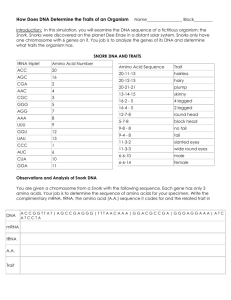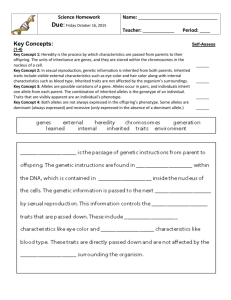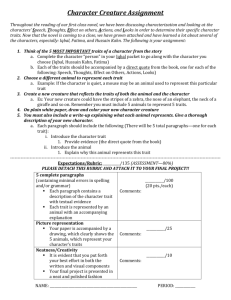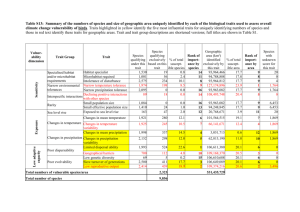A Recipe for Traits Background: There are hundreds of official dog
advertisement
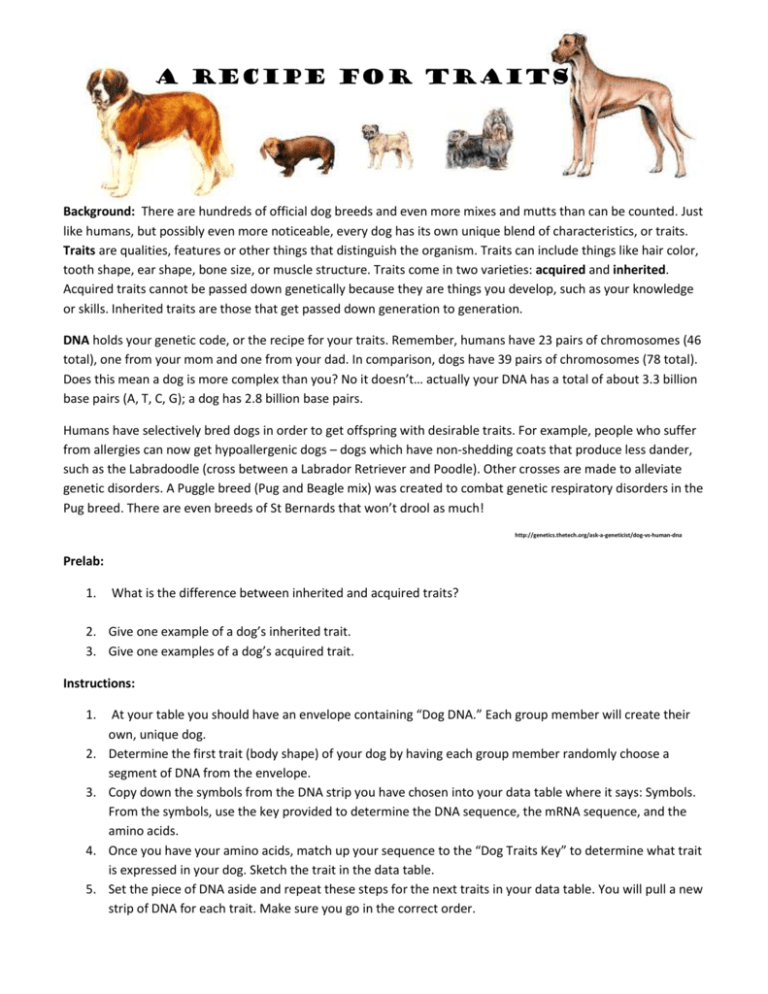
A Recipe for Traits Background: There are hundreds of official dog breeds and even more mixes and mutts than can be counted. Just like humans, but possibly even more noticeable, every dog has its own unique blend of characteristics, or traits. Traits are qualities, features or other things that distinguish the organism. Traits can include things like hair color, tooth shape, ear shape, bone size, or muscle structure. Traits come in two varieties: acquired and inherited. Acquired traits cannot be passed down genetically because they are things you develop, such as your knowledge or skills. Inherited traits are those that get passed down generation to generation. DNA holds your genetic code, or the recipe for your traits. Remember, humans have 23 pairs of chromosomes (46 total), one from your mom and one from your dad. In comparison, dogs have 39 pairs of chromosomes (78 total). Does this mean a dog is more complex than you? No it doesn’t… actually your DNA has a total of about 3.3 billion base pairs (A, T, C, G); a dog has 2.8 billion base pairs. Humans have selectively bred dogs in order to get offspring with desirable traits. For example, people who suffer from allergies can now get hypoallergenic dogs – dogs which have non-shedding coats that produce less dander, such as the Labradoodle (cross between a Labrador Retriever and Poodle). Other crosses are made to alleviate genetic disorders. A Puggle breed (Pug and Beagle mix) was created to combat genetic respiratory disorders in the Pug breed. There are even breeds of St Bernards that won’t drool as much! http://genetics.thetech.org/ask-a-geneticist/dog-vs-human-dna Prelab: 1. What is the difference between inherited and acquired traits? 2. Give one example of a dog’s inherited trait. 3. Give one examples of a dog’s acquired trait. Instructions: 1. 2. 3. 4. 5. At your table you should have an envelope containing “Dog DNA.” Each group member will create their own, unique dog. Determine the first trait (body shape) of your dog by having each group member randomly choose a segment of DNA from the envelope. Copy down the symbols from the DNA strip you have chosen into your data table where it says: Symbols. From the symbols, use the key provided to determine the DNA sequence, the mRNA sequence, and the amino acids. Once you have your amino acids, match up your sequence to the “Dog Traits Key” to determine what trait is expressed in your dog. Sketch the trait in the data table. Set the piece of DNA aside and repeat these steps for the next traits in your data table. You will pull a new strip of DNA for each trait. Make sure you go in the correct order. Data: Using the following key, complete your dog’s DNA, mRNA, and sequence of amino acids. Puzzle piece: ACC Cross: GGC Swirl: TAG Sunburst: GCA Trait Body Head Ears Legs Eyes Tail Color Hair Sketch of Trait Symbols: DNA: mRNA: AA: Trait: Symbols: DNA: mRNA: AA: Trait: Symbols: DNA: mRNA: AA: Trait: Symbols: DNA: mRNA: AA: Trait: Symbols: DNA: mRNA: AA: Trait: Symbols: DNA: mRNA: AA: Trait: Symbols: DNA: mRNA: AA: Trait: Symbols: DNA: mRNA: AA: Trait: Discussion Questions: 1. If you put together your entire strand of different colored strips, what does it represent? 2. Each trait of your dog was coded for by a segment of your entire strand. What is this segment of DNA called? 3. Each segment of DNA contained 4 symbols. The symbols were made up of a three-letter base group. What are these three-letter base groups called? 4. Each symbol contains 1 codon. Each of those codons translates into an amino acid. So, your entire segment of DNA codes for a string of amino acids. What is that string of amino acids and how does it create the trait you see in your dog? 5. Look at your DNA segment for Head Shape. Compare & contrast your segment one of your group member’s segment. How are they similar? How are they different? 6. Why do these similarities and differences matter? In other words, how do these similarities and differences create varying traits in the dogs of your group members? 7. How is this model of traits oversimplified? 8. On the back of this sheet, use the entire sheet to draw your dog, making sure to display all its traits. It must be in color!



